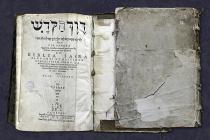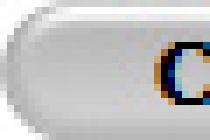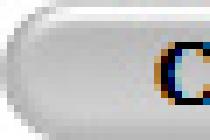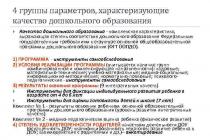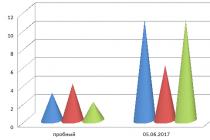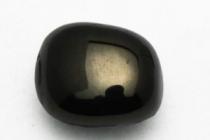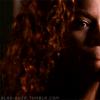Many needlewomen “the old fashioned way” use a pencil to mark seams, patterns and ornaments. However, washing a simple pencil from canvas and white fabric is not an easy task. Special products that can be easily prepared at home will help you deal with strokes.
Recipe for an effective soap product. Required components:
- Antipyatin soap;
- laundry soap;
- oxygen bleach;
- synthetic detergent;
- dishwashing liquid.
Preparation:
Mix the ingredients in one bowl and stir thoroughly. Apply the prepared product to the contaminated surface, leave for a day, and then soak in warm water for 7-8 hours. If traces remain, add a little synthetic cleaner to the water. Rinse the fabric thoroughly under running water to remove any residue. Additionally, wash in a washing machine with a suitable program.
How to remove a simple pencil from embroidery and canvas?
If you need to remove pencil marks very quickly, use ready-made stain removers - “Ac” or “Vanish”. Before washing, be sure to read the instructions to avoid negative consequences. Cleaning powder can be added during washing or applied directly to the dirty area. There are products designed for colored and white fabrics. Take this into account when choosing them.
How to remove pencil from white fabric?
You will need a simple laundry soap that will help deal with stains no worse than expensive products. Soak the contaminated cloth in warm water, thoroughly rub the stained area with a piece of laundry soap, and leave for half an hour. Rub the fabric with soap again and rinse thoroughly. Additionally, wash it in a washing machine with a suitable setting.

How and with what to wash a pencil from a canvas
Another simple but effective remedy is Antipyatin soap. It is used in exactly the same way as laundry soap. Soak the dirty area, rub thoroughly with a bar of soap, let it sit for 20 minutes, rub with soap again and rinse thoroughly in clean water. All that remains is to wash the product in the washing machine.
Some more effective ways:
- Gel "Vanish". Prepare a plastic cup, pour a little gel into it (about half). The amount of gel will depend on the size of the stain. Place in a bowl (without water) and leave for 4 hours. Add water, rub the contaminated areas with laundry soap, and leave again for several hours. Additionally, scrub the fabric with a brush (light movements), rinse and wash in the washing machine. If dirt remains, repeat the procedure again.
- If you use a pencil for marking, starch the fabric before embroidering. After finishing work, simply wash the product with detergent. The fingerprint marks will easily come off along with the starch.
- If the marks are not very strong, try erasing the pencil with a simple school eraser.
- Pour warm water into a basin, add 2-3 caps of Ariel, stir the contents a little, immerse the embroidery or sewing, stir again and leave overnight. Wash the product in the morning and rinse in clean water.
- Treat the item with detergent, rinse in cold water, add 2-3 drops of ammonia, treat the fabric with detergent again and rinse in clean water.
- Roll a small ball from the bread crumb, place it in your palm and “roll” it over the contaminated surface. Breadcrumbs literally “roll out” the fingerprint marks. To begin with, you can practice on paper. Finally, blow off the bread crumbs and wash the items if necessary.
- If all else fails, try drastic measures. For example, use WD-40. Spray a small area and then gently rub with a cloth. If the fabric is delicate, try this method of application. Spray paper napkins with WD-40 and apply to the stain on both sides. Leave the wipes on for 2 minutes and rub a few drops of dish detergent into the stain. Gradually, the napkins will begin to color, absorbing the pencil marks. Change napkins every 2 minutes. Wash the fabric in the washing machine.
- If you need to remove crayon from upholstery or carpet, try using a dull knife. After most of the dirt has been removed, moisten it with WD-40 and leave for 5 minutes. Rub the mark with a stiff brush, treat with a paper napkin, add another drop of WD-40, add a couple of drops of detergent, scrub the mark with a brush, and moisten with a damp washcloth.
A hackneyed movie image with a trace of red lipstick on the collar of a white men's shirt hints at a romantic twist in the plot. In real life, makeup stains on your favorite dress or bag are more likely to turn into tears.
Dropped a nail polish brush on your new jeans? Met with brightly painted lips and a scarf? Or - well, who hasn't happened to them - they wiped off the foundation from their face with the collar of their T-shirt? Before you panic and frantically scrub the stained item with a napkin, take a deep breath and calmly get down to business. We'll fix everything! Especially if you follow the instructions.
PHOTO getty images
General rules for removing stains
1. Fresh (not older than three hours old) stains are easier to remove than dried and firmly absorbed stains. Therefore, we must act quickly.
2. If the stain is fresh, first blot it with a dry paper towel so that it absorbs as much of the cosmetic as possible. Now sprinkle the stain with salt or baby powder, they absorb grease very well.
3. If several hours have passed since the incident and the stain has dried, remove the top layer with a plastic spoon.
4. Remove the stain from the wrong side of the fabric by placing paper napkins underneath.
5. Never rub the stain: it will only absorb it more thoroughly. The movements should be blotting.
6. When purchasing a stain remover, be guided by the type of stain and the type of material that needs cleaning. Please read the instructions first and strictly follow them.
7. For any stain removers, both homemade and industrial, first test on a small area of fabric, not the most visible part of the product. If the color remains the same, you can proceed.

8. Begin removing dirt using a weak solution. If necessary, gradually increase the concentration.
9. Peroxide and other stain-fighting products should not be poured onto the stain, but applied with soaked cotton pads or a soft-bristled toothbrush (for example, for very young children). First, treat the area around the stain, then the edges, and only then start working on the middle. This technique will prevent the stain from spreading.
10. After local processing, wash the item completely. First, read the information on the label about caring for the damaged item: what is allowed for silk is not allowed for linen.
11. Do not attempt to remove stains or stains in the washing machine, especially with the drying cycle on. After this, it will be almost impossible to remove traces.
Process
Beauty products can be oil-based (cream) or contain no fat at all (powder). This will depend on your choice in the store or homemade solution for removing cosmetics. A universal remedy that works with most types of stains is ammonia and salt diluted in water, but it is not omnipotent. Therefore, let’s look at each type of cosmetics in more detail.

All of these and other creamy beauty products are mostly made up of oils and/or waxes. You can’t wash them with plain water; on the contrary, it will worsen the situation. You will need fat dissolving agents.
First way. The simplest and most affordable means for removing traces of lipstick or tone from fabric is dishwashing detergent or shampoo. Take something that does not contain moisturizing components - there is no need for excess fat in this case. After the steps with a napkin and salt, apply a little product (a couple of drops in a 1:2 ratio to water is enough) and leave for five minutes. Then rinse with warm water.
Second way. Spray hairspray onto the stain. Leave for 10 minutes, then wipe with a clean cloth or sponge. Wash it.
Third option. Sprinkle baking soda on the stain, and after a few minutes, extinguish it with a mixture of warm water and lemon juice or vinegar. And throw it in the wash.
Number four is a 3% hydrogen peroxide solution. It is especially effective against self-tanners and other cosmetics with orange pigment.
Sprinkle traces of blush, eye shadow, powder with washing powder. After 15 minutes, wash in the manner recommended for the affected item.

Mascara and eyeliner
It’s not for nothing that special two-phase removers are produced for mascaras and eyeliners, especially waterproof ones: you can’t just get rid of them. It makes sense to use these makeup removers if mascara ends up not only on your eyelashes, but, for example, on your sleeve. Follow the protocol: shake the bottle well, apply a little liquid to a cotton pad, lightly blot the stain and wash. To avoid having to deal with oil stains from a two-phase toner, use micellar water. It consists of special particles, micelles, which adhere to dirt molecules and are washed away along with them.
Removing regular (non-gel) nail polish from fabric is almost as easy as removing it from your fingernails. Just don't reach for the bottle of acetone. If you accidentally spill polish on your dress, let it dry and then tape it down. Rip off the tape with a sharp movement, as if it were a wax strip for hair removal. The varnish should leave a pale trace that can be removed by the washing machine. If trouble happens to your favorite leather jacket or bag, after removing the stain, apply leather furniture conditioner to the damaged area. Follow the instructions on the package and be sure to wear rubber gloves.

Hair dye
Hair dye marks on a towel or T-shirt are one of the most difficult cases. If a cocktail of equal parts of ammonia and hydrogen peroxide or ammonia and water in a ratio of 1:5 with the addition of salt (a teaspoon per glass of solution) does not help, you will have to buy a stain remover. Or use this thing for further hair coloring at home.
If you can't get rid of the stain on the first try, repeat one or more times until the end. If all else fails, go to the dry cleaner.
Many needlewomen use a pencil to make drawings or markings when creating their creations.
And after that they are faced with the problem of removing the graphite mixture from the fabric. In fact, it is quite difficult to remove it, but nothing is impossible.
Pencil cannot be removed from fabric material using an eraser. The thing is that its action is based on the fact that, together with graphite, it removes the top layer of paper. This won't work with fabric. That is why it is better to use such means as:
- Washing powder;
- Vanish;
- Soap;
- Special elastic band;
- Dishwashing liquid and some other preparations.
They will help you get rid of the pencil, but you need to use them correctly. If you act at random, it will be even worse. In view of this, you should act strictly according to the instructions.
What works well for removing stains is dishwashing liquid.

- In this case, you need to moisten the sponge in warm water and apply a little detergent to it.
- Then the stain is rubbed in a circular motion.
- After you see that it has disappeared, wash the treated area with warm water and let it dry.
If you can’t remove the defect the first time, apply detergent to the stain and leave it for a day. Then all that remains is to wash it. It is important to set the washing machine to a program that suits your material.
How to wash a pencil? There are several more ways.
- Lather the graphite strips with laundry soap.
- Leave them for half an hour.
- Rinse, lather again, wash.
- Then all that remains is to rinse the fabric thoroughly.
Use of Vanish and similar products
Pencil lead stains are easily removed by Vanish and similar products. In this embodiment, the product is diluted and used according to the instructions.
As reviews say, the defect is removed very quickly. This way you can remove stains from both colored and white fabrics.
What products can be used besides Vanish? Ac, Amway or Antipyatin will do the job perfectly. They are not that expensive, but they will definitely have an effect.
There is another answer to the question: “how to wash a pencil?” - use a special rubber band or eraser.

You can buy it at a store that sells fabric. The principle of operation of the product is quite simple - it wipes the mark. Eventually he disappears.
Important! A special elastic band should not be expensive, but not too cheap either. The material should not be ironed before applying the product. Only then will it help.
Wash
Getting rid of a simple pencil lead on fabric can also be done by washing. But this method does not always help. However, if the powder is strong, then it can cope with the problem.
Important! Before you start washing, it is better to soak the product for a day.
If there is no effect, you can take the item to the dry cleaner. They should be able to remove such stains. If this doesn't help, try all of the above options. One of them must come up, the main thing is not to give up and fight to the last.
Are you lucky enough to become the parents of a young talent for whom the whole house is an artistic canvas? Your child turns walls, furniture and other objects into intricate art objects, and you grab your head wondering how to clean it all?
Indeed, when the new wallpaper is covered with sweeping scribbles, it’s hard for mom to be happy - after all, it’s she who has to shed sweat in the fight with the “masterpiece.”
Calm, just calm. the site will share with you simple techniques that will help remove traces of children's creativity from various surfaces and return your apartment and clothes to their original appearance.

Let's start with the most harmless tool for art - a pencil. To deal with marks both from a simple pencil with a graphite lead and from its colored counterpart, just use a soft eraser. When erasing slate marks from embossed wallpaper, you need to be extremely careful, do not overdo it, so as not to damage the canvas.
You can remove the pencil from the fabric by using a toothbrush with a drop of dishwashing detergent. The fabric must be gently rubbed and then washed.

If the child chose walls covered with paper wallpaper as a pictorial object, then we have bad news for you. It will not be possible to revive such wallpaper. All that remains is to come to terms with the upcoming repairs. But watercolor or gouache from vinyl wallpaper can be washed off with a soap solution at room temperature.
Gouache and watercolor can be easily removed from clothing using any oxygen bleach.

When buying a set of felt-tip pens for a child, you should choose children's felt-tip pens with water-based ink rather than alcohol-based ink. This will make your life much easier in the future. The water-based paint of such a felt-tip pen can be easily wiped off from surfaces with a damp sponge soaked in soapy water.
If your baby gets to your permanent markers or you accidentally bought alcohol markers for... children's creativity- don't be upset. Although it is more difficult to remove such paint, it is possible. Attack the stain with regular penny hydrogen peroxide, use oxygen bleach, or make your own stain remover - take 1 part baking soda, 1 part alcohol, mix, wet a cotton pad and gently rub the stain with it. Be careful not to smudge! When dealing with art, move from the edge to the center of the paint spot.
Fabric stained with a felt-tip pen can be cleaned, among other things, with soda. Sprinkle some powder onto a damp sponge and go over the stain. Unfortunately, the fabric fibers are slightly damaged.

The basis of the mixture for wax crayons is paraffin and coloring pigments, and therefore the stroke from this artistic tool turns out to be greasy and does not wash off well. But the kids really love to draw with them, because the picture comes out so bright and “juicy”! But it happens that the child gets too carried away with creativity and forgets that he needs to draw on the paper intended for this. To get rid of an unauthorized masterpiece, you need to use an iron. Apply printer paper or old newspaper to the wax mark and smooth the surface with the hot sole of an iron. Repeat the procedure until the paper stops getting greasy. Then apply dry baby powder to the doodle area and let it absorb any remaining paraffin.

Pen paste is one of the worst evils, which is quite difficult to deal with. Try making and using this stain remover: mix one part acetone (contact your husband, he should have it in his garage) and one part alcohol, dip an ear stick into the solution and carefully wipe the mark from the pen, avoiding the unaffected surface. Change the cotton swab when it gets dirty. Instead of acetone, you can use acetone-containing nail polish remover. Or try removing ink blots using chlorine bleach. Be careful - all these products are aggressive! Take precautions.
A safe way to remove ballpoint pen paste stains from clothes is to use sour milk. Soak the fabric in it for several hours, and then wash it in soapy water with a couple of drops of ammonia.

If you have a young sculptor growing up in your family who decorates his father’s house with intricate plasticine stucco, then the rooms are probably full of traces of this type of creativity. We can offer several methods of saving you from greasy plasticine stains. The first method is perfect for cleaning the surfaces of tables and chairs: take a piece of ice and apply it to the plasticine, then use a spatula to scrape off the frozen mass. Don't hesitate! If you miss the moment, the fatty component of the material will saturate the surface and getting rid of the stain will become problematic.
If a child dropped his masterpiece on the carpet, where it was thoroughly rubbed into the fibers, then the damaged surface needs to be “treated” with an iron. The method was described above when we told you how to get rid of stains from wax crayons.
To clean clothes, you need to put them in the freezer until the plasticine is completely petrified. Then, try to remove the adhered material mechanically. Next, treat the “problem” area with soapy water and leave for 15 minutes, after which scrub the stain with a toothbrush (you can use soda).
Unfortunately, oily traces of plasticine cannot be removed from paper wallpaper. All that remains is to conclude that such wallpaper is not suitable for a home where children grow up.
Concerning choosing plasticine, then now there is an excellent alternative to the usual classic one - wax plasticine. It is more flexible and easier to mold, and most importantly, it gets dirty less! There is another option - soft plasticine in jars, which hardens in air. Yes, dried material is not suitable for reuse, as it becomes brittle and crumbles easily. But such a craft, forgotten somewhere on the carpet, will not melt in the heat and will not upset you with a colored puddle ingrained into the surface.
Tips for parents of little creative lovers

All children love to draw and sculpt. In addition, creative activities are useful for fine motor skills and contribute to the overall development of the child. Therefore, children’s arts cannot be prevented, even if the child damages the furniture. Try to explain to your child that there are specially designated places and surfaces for drawing and modeling, but do not rely too much on obedience. For your part, you can minimize the level of damage by purchasing water-based, easily washable art supplies for children. If you are doing renovations, before purchasing wall material, consult with a specialist and tell them that a child is growing up in your home.
If the child is still too young to accept your rules of the creative process and it is not possible to fight the arts, and repairs are not planned, you need to provide the young creator with all the conditions for self-realization. Protect the wallpaper by attaching sheets of thick Whatman paper to the walls.
Each child is the pride of his parents, the fruit of their joint creation. A talented child is doubly proud. Be patient in your good work of raising your offspring and rejoice in your child’s success - after all, this is your success, don’t forget! And damaged wallpaper is, after all, just a piece of paper.
Be happy!
Many needlewomen “the old fashioned way” use a pencil to mark seams, patterns and ornaments. However, washing a simple pencil from canvas and white fabric is not an easy task. Special products that can be easily prepared at home will help you deal with strokes.
Recipe for an effective soap product. Required components:
- Antipyatin soap;
- laundry soap;
- oxygen bleach;
- synthetic detergent;
- dishwashing liquid.
Preparation:
Mix the ingredients in one bowl and stir thoroughly. Apply the prepared product to the contaminated surface, leave for a day, and then soak in warm water for 7-8 hours. If traces remain, add a little synthetic cleaner to the water. Rinse the fabric thoroughly under running water to remove any residue. Additionally, wash in a washing machine with a suitable program.
How to remove a simple pencil from embroidery and canvas?
If you need to remove pencil marks very quickly, use ready-made stain removers - “Ac” or “Vanish”. Before washing, be sure to read the instructions to avoid negative consequences. Cleaning powder can be added during washing or applied directly to the dirty area. There are products designed for colored and white fabrics. Take this into account when choosing them.

How to remove pencil from white fabric?
You will need a simple laundry soap that will help deal with stains no worse than expensive products. Soak the contaminated cloth in warm water, thoroughly rub the stained area with a piece of laundry soap, and leave for half an hour. Rub the fabric with soap again and rinse thoroughly. Additionally, wash it in a washing machine with a suitable setting.

How and with what to wash a pencil from a canvas
Another simple but effective remedy is Antipyatin soap. It is used in exactly the same way as laundry soap. Soak the dirty area, rub thoroughly with a bar of soap, let it sit for 20 minutes, rub with soap again and rinse thoroughly in clean water. All that remains is to wash the product in the washing machine.
Some more effective ways:
- Gel "Vanish". Prepare a plastic cup, pour a little gel into it (about half). The amount of gel will depend on the size of the stain. Place in a bowl (without water) and leave for 4 hours. Add water, rub the contaminated areas with laundry soap, and leave again for several hours. Additionally, scrub the fabric with a brush (light movements), rinse and wash in the washing machine. If dirt remains, repeat the procedure again.
- If you use a pencil for marking, starch the fabric before embroidering. After finishing work, simply wash the product with detergent. The fingerprint marks will easily come off along with the starch.
- If the marks are not very strong, try erasing the pencil with a simple school eraser.
- Pour warm water into a basin, add 2-3 caps of Ariel, stir the contents a little, immerse the embroidery or sewing, stir again and leave overnight. Wash the product in the morning and rinse in clean water.
- Treat the item with detergent, rinse in cold water, add 2-3 drops of ammonia, treat the fabric with detergent again and rinse in clean water.
- Roll a small ball from the bread crumb, place it in your palm and “roll” it over the contaminated surface. Breadcrumbs literally “roll out” the fingerprint marks. To begin with, you can practice on paper. Finally, blow off the bread crumbs and wash the items if necessary.
- If all else fails, try drastic measures. For example, use WD-40. Spray a small area and then gently rub with a cloth. If the fabric is delicate, try this method of application. Sprinkle paper napkins with WD-40 and apply to the stain on both sides. Leave the wipes on for 2 minutes and rub a few drops of dish detergent into the stain. Gradually, the napkins will begin to color, absorbing the pencil marks. Change napkins every 2 minutes. Wash the fabric in the washing machine.
- If you need to remove crayon from upholstery or carpet, try using a dull knife. Once most of the dirt has been removed, moisten it with WD-40 and leave for 5 minutes. Scrub the mark with a stiff brush, treat with a paper napkin, add another drop of WD-40, add a couple of drops of detergent, scrub the mark with a brush, and moisten with a damp washcloth.
Marks from pencils and colored pencils are very difficult to remove. To mark embroidery patterns, it is better to use special markers or thread. It takes a long time to remove marks on furniture upholstery and carpet. But there will definitely be a result. If one method does not help, another will help. The main thing is not to give up!


